| Trucker's hitch | |
|---|---|
 Trucker's hitch with alpine butterfly loop | |
| Names | Trucker's hitch, dolly knot, Wakos transport knot,[1] lorry driver's hitch,[2] harvester's hitch,[2] hay knot,[3] sheepshank cinch,[3] trucker's dolly,[4] wagoner's hitch,[4] power cinch,[5] rope tackle[6] |
| Category | Hitch |
| Related | versatackle knot, sheepshank |
| Typical use | Making a rope very tight, such as to secure an object to a vehicle |
| Caveat | Can produce excessive wear on rope, especially if tied repeatedly in the same spot[6] |
| ABoK | #1514, #2124, #2125, #2126 |
| Instructions | |
The trucker's hitch is a compound knot commonly used for securing loads on trucks[7] or trailers. The general arrangement, using loops and turns in the rope itself to form a crude block and tackle, has long been used to tension lines and is known by multiple names.[2][3] Knot author Geoffrey Budworth claims the knot can be traced back to the days when carters and hawkers used horse-drawn conveyances to move their wares from place to place.[8]
Variations
The portion of the trucker's hitch which differs in the following variations is the method used to form the loop which the working end slides through to produce the mechanical advantage. The different methods of forming the loop affect the ease and speed of tying and releasing, and the stability of the final product.
The variations are presented in order of increasing stability.
Sheepshank style loop
This version of the knot uses a sheepshank,[9] in this kind of application also known as a bell ringer's knot, to form the loop. It is quicker to make than a fixed loop, but is less dependable.[2][10] It is avoided in critical applications (such as securing a load on a truck) as it can fall apart under too little load or too much load, and can capsize if not dressed properly.[4] However, this knot may be made secure by adding a Half Hitch to the top bight of the Sheepshank. This form of the trucker's hitch is least likely to jam, coming apart easily once tension is released. Different sources show slight variations in the way the sheepshank portion is formed and dressed.
Versions popular in East Asia use variations of sheep shank using either a simple half hitch[11] or a double turn self crossing half hitch[12] or a triple turn self crossing half hitch.[13] A sheep shank with two consecutive half hitches i.e. a clove hitch to secure the upper eye and to form the lower eye is more popular in the west.
Slipped overhand loop
The loop formed in one version is a simple Slipped Overhand Loop. This version is good for light to moderate loads
Simple friction loop
Another version uses a multiply twisted bight to pass a bight of the working end to form the eye of the loop. This version tolerates higher load.[14]
Fixed loop
The most reliable common variation uses a fixed loop, such as an alpine butterfly loop, artillery loop, figure-eight loop or directional figure-eight loop, or another of many suitable loop knots.[4][15] If a fixed loop is used repeatedly for tying the trucker's hitch in the same portion of rope, excessive wear or other damage may be suffered by the portion of the loop which working end slides against.[2]
If extra loops are used to form the eye it tends to ease untying. In order to prevent the closing of the loop under load, the loop must be formed by the working end of the rope (which will later pass through the loop). If the standing end goes through the loop, it will close under load.
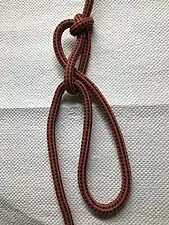 Truckers' Hitch With Simple Slip knot as upper loop
Truckers' Hitch With Simple Slip knot as upper loop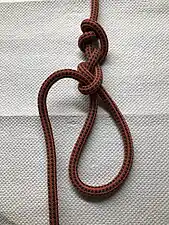 Truckers' Hitch With Twisted Slip knot as upper loop
Truckers' Hitch With Twisted Slip knot as upper loop Truckers' Hitch With Figure-eight slip knot / noose as upper loop
Truckers' Hitch With Figure-eight slip knot / noose as upper loop Truckers' Hitch With Half hitch sheep shank as upper loop
Truckers' Hitch With Half hitch sheep shank as upper loop Truckers' Hitch With Double Half hitch sheep shank as upper loop
Truckers' Hitch With Double Half hitch sheep shank as upper loop Truckers' Hitch With Triple Half hitch sheep shank as upper loop
Truckers' Hitch With Triple Half hitch sheep shank as upper loop A version of the trucker's hitch based on the sheep shank using two consecutive half hitches i.e. a clove hitch.
A version of the trucker's hitch based on the sheep shank using two consecutive half hitches i.e. a clove hitch.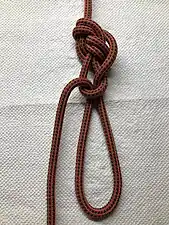 Truckers' Hitch With Figure-eight loop as upper loop. A directional figure-eight loop could be more suitable.
Truckers' Hitch With Figure-eight loop as upper loop. A directional figure-eight loop could be more suitable.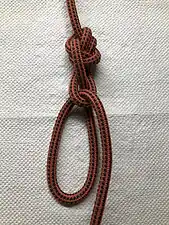 Truckers' Hitch With Overhand loop as upper loop
Truckers' Hitch With Overhand loop as upper loop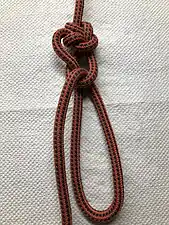 Truckers' Hitch With Artillery loop as upper loop
Truckers' Hitch With Artillery loop as upper loop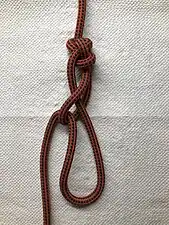 Truckers' Hitch With Span loop as upper loop
Truckers' Hitch With Span loop as upper loop Truckers' Hitch With Bowline on the bight as upper loop
Truckers' Hitch With Bowline on the bight as upper loop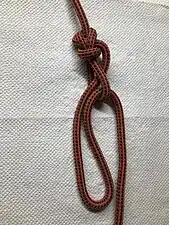 Truckers' Hitch With Angler's loop as upper loop
Truckers' Hitch With Angler's loop as upper loop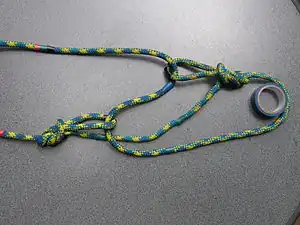 A double friction loop version of the trucker's hitch with even more mechanical advantage
A double friction loop version of the trucker's hitch with even more mechanical advantage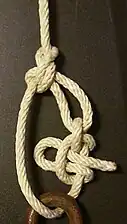
Finishing the hitch

In tightening the trucker's hitch, tension can be effectively increased by repeatedly pulling sideways while preventing the tail end from slipping through the loop, and then cinching the knot tighter as the sideways force is released. This is called "sweating a line".[16]
If the tail end is wrapped through the last loop twice, the resulting friction may render manual cinching unnecessary.
Once tight, the trucker's hitch is often secured with a half hitch, usually slipped for easy releasing and to avoid the necessity of access to the end of the rope, though a more secure finish, such as two half-hitches, may be called for. Under large loads, the finishing half hitch can jam, especially if it is not slipped; the difficulty of releasing it can be compounded by the fact that the knot is typically still under tension when it is untied.
Finishing with a taut-line hitch or a Farrimond friction hitch to the standing part allows the finishing knot to be tied and untied with no tension. This eliminates any jamming problems and also allows the line to be re-tensioned if necessary.
A mechanical advantage of ideally 3:1 can nearly be achieved when using an equivalent setup with pulleys,[17][18] but is reduced substantially by friction when using knots.
Cultural references
The trucker's hitch knot is portrayed by comedy duo Ylvis in their 2014 song with the same name. The lyrics and the video pretend (in a humorous way) to demonstrate how to tie the knot.[19]
See also
References
- ↑ Lofty Wiseman, The Sas Survival Handbook
- 1 2 3 4 5 Des Pawson (2002), Pocket Guide to Knots & Splices, Edison, NJ: Chartwell Books, Inc., p. 142
- 1 2 3 Cyrus Lawrence Day (1986), The Art of Knotting and Splicing (4th ed.), Annapolis: Naval Institute Press, p. 116
- 1 2 3 4 Gordon Perry (2006), Knots, North Vancouver: Quantum Publishing, pp. 134–135
- ↑ Cliff Jacobson (1977), Wilderness Canoeing & Camping, Dutton, p. 118,
...there seems to be no widely accepted name for this hitch, so I took the liberty of naming it the power-cinch
- 1 2 Riley, Howard W. (January 1912). "Knots, Hitches, and Splices". The Cornell Reading-Courses. Rural Engineering Series No. 1. Ithaca, NY: New York State College of Agriculture at Cornell University. 1 (8): 1428. Retrieved 2011-11-08. As collected in Documents of the Assembly of the State of New York, 136th Session, 1913, Vol. 19, No. 29, Part 5.
- ↑ Heavy Vehicle Road Code, New Zealand, 2016
{{citation}}: CS1 maint: location missing publisher (link) - ↑ Geoffrey Budworth (1999), The Ultimate Encyclopedia of Knots, London: Hermes House, pp. 224–225
- ↑ https://www.youtube.com/watch?v=JBh7_cw2-1s&t=300s very practical, quick, traditional trucker's hitch
- ↑ Ashley, Clifford W. (1944), The Ashley Book of Knots, New York: Doubleday, p. 344,
A quicker but less dependable lashing is based on the Bell Ringer's Knot #1148.
- ↑ https://www.youtube.com/watch?v=jTiGUYhW1A8 Truckers' hitch using a simple turn half hitch sheep shank eye
- ↑ https://www.youtube.com/watch?v=_Y4xcd-e6rA Truckers' hitch using a double and crossing turn sheep shank eye
- ↑ https://www.youtube.com/watch?v=H9_yT8HJF64 Trucker's hitch using a double and crossing turn sheep shank upper eye, and twisted lower eye
- ↑ https://www.youtube.com/watch?v=tvgFyqFZK54 The Truckers' Hitch - tied 3 different ways
- ↑ Ashley, p. 271
- ↑ John Mellor (1996), Handling Troubles Afloat, Dobbs Ferry, NY: Sheridan House, pp. 195–196
- ↑ Compton, Nic (2013). The Knot Bible. Adlard Coles Nautical. p. 74. ISBN 978-1-4081-5476-2.
- ↑ Tilton, Buck (2019). Outward Bound - Ropes, Knots, and Hitches. Falcon. p. 34. ISBN 978-1-4930-3503-8.
- ↑ Video on YouTube
External links
- Grog. "Trucker's Hitch". Animated Knots. Retrieved 12 February 2013.